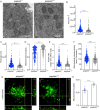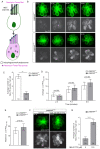Pregnancy-associated plasma protein-aa regulates endoplasmic reticulum-mitochondria associations
- PMID: 33759764
- PMCID: PMC8024009
- DOI: 10.7554/eLife.59687
Pregnancy-associated plasma protein-aa regulates endoplasmic reticulum-mitochondria associations
Abstract
Endoplasmic reticulum (ER) and mitochondria form close physical associations to facilitate calcium transfer, thereby regulating mitochondrial function. Neurons with high metabolic demands, such as sensory hair cells, are especially dependent on precisely regulated ER-mitochondria associations. We previously showed that the secreted metalloprotease pregnancy-associated plasma protein-aa (Pappaa) regulates mitochondrial function in zebrafish lateral line hair cells (Alassaf et al., 2019). Here, we show that pappaa mutant hair cells exhibit excessive and abnormally close ER-mitochondria associations, suggesting increased ER-mitochondria calcium transfer. pappaa mutant hair cells are more vulnerable to pharmacological induction of ER-calcium transfer. Additionally, pappaa mutant hair cells display ER stress and dysfunctional downstream processes of the ER-mitochondria axis including altered mitochondrial morphology and reduced autophagy. We further show that Pappaa influences ER-calcium transfer and autophagy via its ability to stimulate insulin-like growth factor-1 bioavailability. Together our results identify Pappaa as a novel regulator of the ER-mitochondria axis.
Keywords: ER stress; IGF signaling; autophagy; cell biology; hair cell; neurodegeneration; neuroscience; zebrafish.
© 2021, Alassaf and Halloran.
Conflict of interest statement
MA, MH No competing interests declared
Figures







Similar articles
-
Pregnancy-associated plasma protein-aa supports hair cell survival by regulating mitochondrial function.Elife. 2019 Jun 17;8:e47061. doi: 10.7554/eLife.47061. Elife. 2019. PMID: 31205004 Free PMC article.
-
Pregnancy-Associated Plasma Protein-aa Regulates Photoreceptor Synaptic Development to Mediate Visually Guided Behavior.J Neurosci. 2018 May 30;38(22):5220-5236. doi: 10.1523/JNEUROSCI.0061-18.2018. Epub 2018 May 8. J Neurosci. 2018. PMID: 29739870 Free PMC article.
-
Complexes of Usher proteins preassemble at the endoplasmic reticulum and are required for trafficking and ER homeostasis.Dis Model Mech. 2014 May;7(5):547-59. doi: 10.1242/dmm.014068. Epub 2014 Mar 13. Dis Model Mech. 2014. PMID: 24626987 Free PMC article.
-
The roles of mitochondria-associated membranes in mitochondrial quality control under endoplasmic reticulum stress.Life Sci. 2019 Aug 15;231:116587. doi: 10.1016/j.lfs.2019.116587. Epub 2019 Jun 18. Life Sci. 2019. PMID: 31220526 Review.
-
Endoplasmic reticulum: ER stress regulates mitochondrial bioenergetics.Int J Biochem Cell Biol. 2012 Jan;44(1):16-20. doi: 10.1016/j.biocel.2011.10.012. Epub 2011 Nov 2. Int J Biochem Cell Biol. 2012. PMID: 22064245 Free PMC article. Review.
Cited by
-
Cadherin-16 regulates acoustic sensory gating in zebrafish through endocrine signaling.PLoS Biol. 2025 May 2;23(5):e3003164. doi: 10.1371/journal.pbio.3003164. eCollection 2025 May. PLoS Biol. 2025. PMID: 40315416 Free PMC article.
-
Cadherin 16 promotes sensory gating via the endocrine corpuscles of Stannius.bioRxiv [Preprint]. 2024 Sep 25:2024.09.23.614609. doi: 10.1101/2024.09.23.614609. bioRxiv. 2024. PMID: 39386705 Free PMC article. Preprint.
References
-
- Area-Gomez E, Del Carmen Lara Castillo M, Tambini MD, Guardia-Laguarta C, de Groof AJ, Madra M, Ikenouchi J, Umeda M, Bird TD, Sturley SL, Schon EA. Upregulated function of mitochondria-associated ER membranes in alzheimer disease. The EMBO Journal. 2012;31:4106–4123. doi: 10.1038/emboj.2012.202. - DOI - PMC - PubMed
Publication types
MeSH terms
Substances
Grants and funding
LinkOut - more resources
Full Text Sources
Other Literature Sources
Molecular Biology Databases

